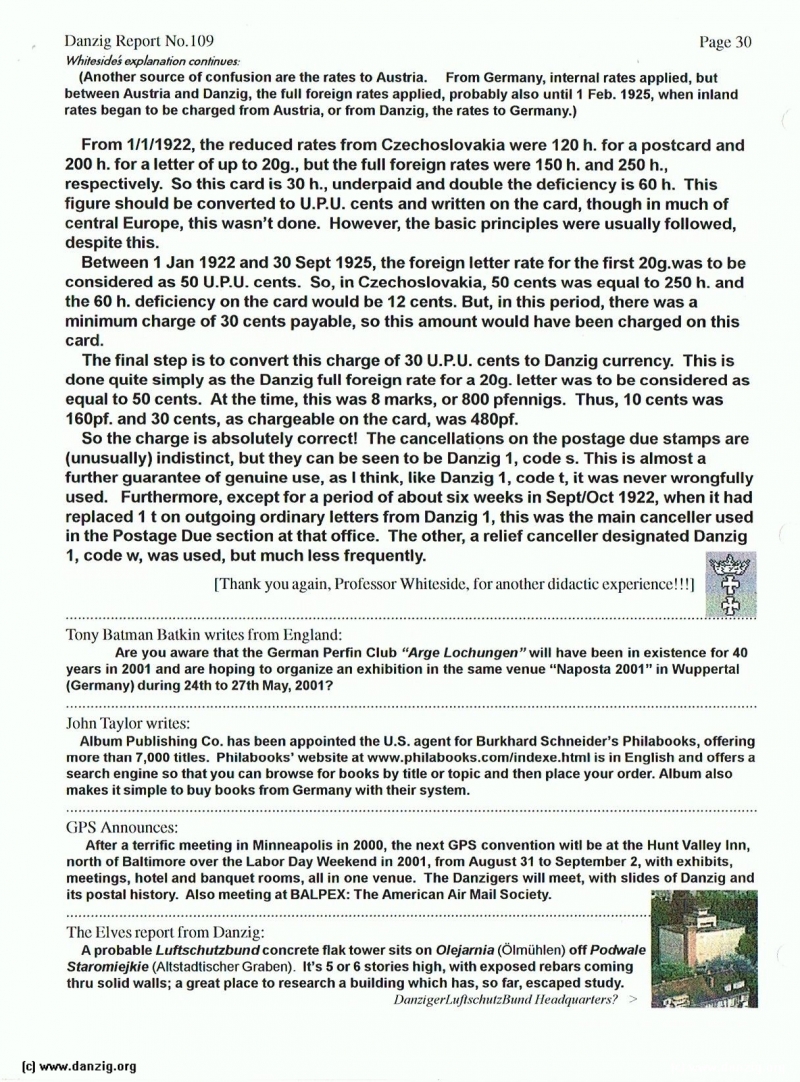
(Another source of confusion are the rates to Austria. From Germany, internal rates applied, but between Austria and Danzig, the full foreign rates applied, probably also until 1 Feb. 1925, when inland rates began to be charged from Austria, or from Danzig, the rates to Germany.)
From 1/1/1922, the reduced rates from Czechoslovakia were 120 h. for a postcard and 200 h. for a letter of up to 20g., but the full foreign rates were 150 h. and 250 h., respectively. So this card is 30 h., underpaid and double the deficiency is 60 h. This figure should be converted to U.RU. cents and written on the card, though in much of central Europe, this wasn’t done. However, the basic principles were usually followed, despite this.
Between 1 Jan 1922 and 30 Sept 1925, the foreign letter rate for the first 20g.was to be considered as 50 U.RU. cents. So, in Czechoslovakia, 50 cents was equal to 250 h. and the 60 h. deficiency on the card would be 12 cents. But, in this period, there was a minimum charge of 30 cents payable, so this amount would have been charged on this card.
The final step is to convert this charge of 30 U.P.U. cents to Danzig currency. This is done quite simply as the Danzig full foreign rate for a 20g. letter was to be considered as equal to 50 cents. At the time, this was 8 marks, or 800 pfennigs. Thus, 10 cents was l6Opf. and 30 cents, as chargeable on the card, was 480pf.
So the charge is absolutely correct! The cancellations on the postage due stamps are (unusually) indistinct, but they can be seen to be Danzig 1, code s. This is almost a further guarantee of genuine use, as I think, like Danzig 1, code t, it was never wrongfully used. Furthermore, except for a period of about six weeks in Sept/Oct 1922, when it had replaced I t on outgoing ordinary letters from Danzig 1, this was the main canceller used in the Postage Due section at that office. The other, a relief canceller designated Danzig 1, code w, was used, but much less frequently.
[Thank you again, Professor Whiteside, for another didactic experience!!! ]
Tony Batman Balkin writes from England:
Are you aware that the German Perfin Club “Arge Lochungen”wiu have been in existence for 40 years in 2001 and are hoping to organize an exhibition in the same venue “Naposta 2001” in Wuppertal (Germany) during 24th to 27th May, 2001?
John Taylor writes:
Album Publishing Co. has been appointed the U.S. agent for Burkhard Schneider’s Philabooks, offering more tliaii 7,000 titles. Philabooks’ website at www.philabooks.com/indexe.html is in English and offers a search engine so that you can browse for books by title or topic and then place your order. Album also makes it simple to buy books from Germany with their system.
GPS Announces:
After a terrific meeting in Minneapolis in 2000, the next GPS convention witl be at the Hunt Valley Inn, north of Baltimore over the Labor Day Weekend in 2001, from August 31 to September 2, with exhibits, meetings, hotel and banquet rooms, all in one venue. The Danzigers will meet, with slides of Danzig and its postal history. Also meeting at BALPEX: The American Air Mail Society.
The Elves report from Danzig:
A probable Luftschutzbund concrete flak tower sits on Olejarnia (Olmuhlen) off Poa wale Staromiejkie (AltstadtischerGraben). It’s 5 or 6 stories high, with exposed rebars coming
thru solid walls; a great place to research a building which has, so far, escaped study.
Danzig Report Vol. 1 - Nr. 109 - October - November - December - 2000, Page 36.
Hits: 3329
Added: 29/07/2015
Copyright: 2025 Danzig.org

